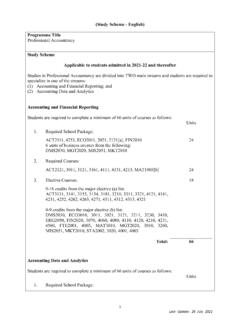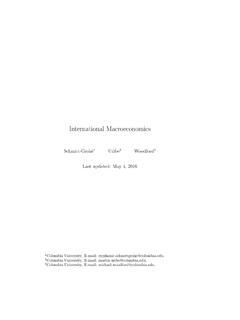Transcription of AP Macroeconomics Full Review - Mr. Eizyk's Social Studies
1 Primary Works Consulted: 1. Notes from Mrs. Joelle Keats , Mr. Nathan Tengowski, and Mr. Jason Mohr s AP Economics Classes 2. Cracking the AP Economics Exams (2015) 3. ACDC econ: #!ap-econ/c18qp 4. Crash Course Economics: AP and Advanced Placement are registered trademarks of the College Board, which does not sponsor or endorse this product. 2015-2016 AP Macroeconomics Full Review VERSION AUTHOR: GABE REN Shared Folder: AP Macroeconomics Full Review Page 1 of 42 Table of Contents Please Read/Background 4 About the Exams .. 4 Resources .. 5 Tips .. 5 Key for Abbreviations .. 6 Macro Unit 1: Measurement of Economic Performance .. 7 DIAGRAM: Circular Flow .. 7 DIAGRAM: Circular Flow (Extended) .. 8 Gross Domestic Product (GDP).. 8 Inflation.
2 9 Real vs. Nominal .. 10 Price Indices .. 10 Unemployment .. 11 Macro Unit 2: National Income and Price Determination .. 13 GRAPH: AS AD .. 13 GRAPH: SRAS (Short Run Aggregate Supply) .. 14 LRAS (Long Run Aggregate Supply) .. 15 AD (Aggregate Demand) .. 15 Cost Push Inflation (Stagflation) .. 16 Demand Pull Inflation .. 16 Classical Analysis (Laissez-Faire) .. 16 Keynesian Analysis .. 17 Theory of Rational Expectations (Classical) .. 17 Macro Unit 3: Fiscal Policy .. 18 Shared Folder: AP Macroeconomics Full Review Page 2 of 42 GRAPH: Recessionary and Inflationary Gaps .. 18 EXAMPLE: AS AD Graph Short Run to Long Run Equilibrium .. 19 Marginal Propensity to Consume (MPC) .. 19 Marginal Propensity to Save (MPS) .. 20 Government Spending Multiplier.
3 20 Tax Multiplier .. 20 EXAMPLE: Balanced Budget Involving 20 Supply Side Economics: Reaganomics (Less Common) .. 21 Government Spending .. 21 GRAPH: Phillips Curve .. 21 Macro Unit 4: Monetary Policy .. 23 Money: Basic Definitions .. 23 Money: Primary Functions .. 23 Money: Types (M1, M2, and M3) .. 23 Fractional Reserve Banking System .. 24 EXAMPLE: Fractional Reserve Banking System .. 25 EXAMPLE: T Account .. 26 Tools of the Fed .. 26 GRAPH: Money Market .. 27 EXAMPLE: Expansionary Monetary 28 GRAPH: Loanable Funds Market .. 29 Crowding Out Effect: Revisited (Yes It s THAT Important) .. 29 Interest Rate Formula (Fisher Effect) .. 30 Equation of Exchange (Monetarist and Classical) .. 30 SUMMARY: Monetary and Fiscal Policies .. 31 Shared Folder: AP Macroeconomics Full Review Page 3 of 42 Key.
4 31 Expansionary Fiscal Policy .. 31 Contractionary Fiscal Policy .. 31 Expansionary Monetary 32 Contractionary Monetary 32 Macro Unit 5: Open Economy: International Trade and Finance .. 33 Balance of Payments .. 33 EXAMPLE: Balance of Payments (2006) .. 34 GRAPH: Forex (Foreign Exchange) Market for Dollars and Yen .. 35 Appreciation .. 36 Depreciation .. 36 Arbitrage (less common) .. 36 Managing Exchange Rates .. 37 Important Graphs and Diagrams .. 38 Circular Flow .. 38 Aggregate Supply and Aggregate Demand (ASAD) .. 38 Short Run Aggregate Supply (SRAS) .. 39 Recessionary and Inflationary Gaps .. 39 Phillips Curve .. 40 T Account .. 40 Money Market .. 41 Loanable Funds Market .. 41 Forex (Foreign Exchange) Market for Dollars and Yen .. 42 Shared Folder: AP Macroeconomics Full Review Page 4 of 42 Please Read/Background Info I.
5 This resource is not meant to teach you economics; rather it is meant to serve as a concise guide for you to Review economic knowledge you have already learned (translation: you still need to pay attention in class) II. Very few parts of this study guide are bolded so pay special attention to bolded sections III. (less common) indicates material that can, but rarely, appears on the AP test IV. GRAPH: or DIAGRAM: indicates the section has an accompanying graph or diagram V. SUMMARY: provides a short summary of a section s material VI. This is the full version of the study guide. Other resources including the condensed version can be found here: About the Exams Around 18% and 15% of people get 5s on the AP Micro and AP Macro tests, respectively1 Shoot for an 80% to 85% on both the MC and FR sections for a 5 I. 60 multiple choice a.
6 70 minutes b. 66% of total score II. 3 free response a. 60 minutes i. 10 minute reading/planning period 1. May begin the test during this time ii. 50 minute solving period b. 33% of total score i. Long FR counts for of this percentage 1. Spend around 25 minutes ii. Two short FR count for of this percentage 1. Spend around 25 minutes 1 Data from the 2015 AP Microeconomics and AP Macroeconomics Tests Shared Folder: AP Macroeconomics Full Review Page 5 of 42 Resources I. AP Central a. Contains course description with practice MC questions and past FR questions b. Micro Homepage: c. Micro FR: d. Macro Homepage: e. Macro FR: II. ACDC econ (Mr. Clifford) a. #!ap-econ/c18qp b. Micro cumulative video Review : c.
7 Macro cumulative video Review : III. Crash Course Economics a. Tips These are applicable to both exams, unless stated otherwise. I. Multiple choice section a. Types of questions i. Economic policy ii. Graphs iii. True vs. false statements b. Use the process of elimination c. Stick with your gut feeling d. Two pass system i. Skip the questions you aren t comfortable with Shared Folder: AP Macroeconomics Full Review Page 6 of 42 1. Come back to them later if you have time ii. Use the letter of the day strategy 1. Guess using the same answer choice e. No penalty for guessing II. Free response section a. Determine which economic tools the question is asking about b. Always draw graphs even if they aren t explicitly asked for i. Label every line and axis ii.
8 Graphs will help you avoid making silly mistakes c. Don t skip steps in your explanation i. Bad answer: expansionary monetary policy shifts AD out ii. Good answer: expansionary monetary policy shifts the money supply curve to the right, thus lowering interest rates which attracts more investment and shifts AD out d. Don t say unnecessary stuff though i. AP graders will take off points for incorrect extraneous information e. As a blanket statement, always think in terms of marginal cost = marginal benefit Key for Abbreviations I. MC = multiple choice II. FR = free response III. PL = price level IV. = factors of production V. Rightward shift = outward shift VI. Leftward shift = inward shift VII. SR = short run VIII. LR = long run IX. e = subscript e = equilibrium X. = delta = change in XI. Fed = federal reserve = central bank Shared Folder: AP Macroeconomics Full Review Page 7 of 42 Macro Unit 1: Measurement of Economic Performance Macroeconomics deals with the whole economy and issues that affect most of society: inflation, unemployment, gross domestic product, national income, interest rates, exchange rates etc.
9 DIAGRAM: Circular Flow I. Visual depiction of goods flowing from firms to households through the product markets and inputs flowing from households through the factor markets II. Doesn t account for leakages into the economy through savings, taxes etc. III. Doesn t account for injections into the economy through exports, foreign investment etc. Shared Folder: AP Macroeconomics Full Review Page 8 of 42 DIAGRAM: Circular Flow (Extended) Gross Domestic Product (GDP) I. Total value of all final goods and services produced in a year within that country a. Does not include intermediate goods which leads to double counting i. lumber which is used to produce homes b. Does not include financial transactions b/c they don t produce anything i. buying and selling of stocks/bonds c.
10 Does not include public and private transfer payments b/c they don t produce anything i. welfare, Social Security II. Expenditure approach of calculating GDP Shared Folder: AP Macroeconomics Full Review Page 9 of 42 a. GDP = C + I + G + X n i. C = personal consumption expenditures 1. Largest proponent of GDP ii. I = investment in new capital by businesses iii. G = gov. purchases iv. Xn = net exports = (exports imports) III. Income approach of calculating GDP (less common) a. GDP = NI + Depreciation Subsidies + Net income of foreigners i. NI = national income 1. Sum of income earned by the by a country s citizens a. Includes wages, salaries, and fringe benefits for labor services, rent, interest on borrowed money, and profits from capital resources ii.


